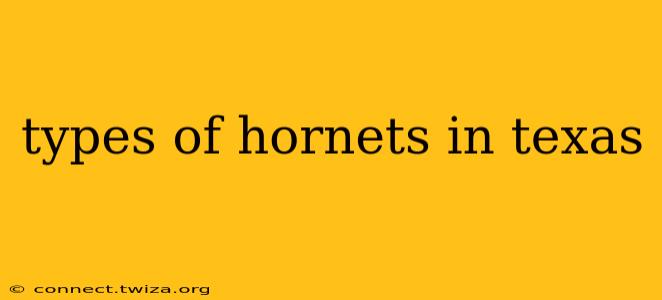Texas, with its diverse ecosystems, is home to several hornet species. Understanding the different types is crucial for safety and effective pest control. This guide explores the common hornet varieties found in the Lone Star State, highlighting their identifying features and behaviors.
What Types of Hornets Live in Texas?
While the term "hornet" is often used loosely, true hornets belong to the genus Vespa. Texas has a few species within the broader wasp family (Vespidae) that are commonly referred to as hornets, even if they aren't technically true hornets. The most prominent include:
-
Bald-faced Hornets (Dolichovespula maculata): These are arguably the most common "hornet" in Texas. They build large, grey paper nests, often high in trees or on structures. They are easily identifiable by their mostly black bodies with white markings on their face and thorax. Their aggressive nature makes them a significant concern for homeowners.
-
Yellow Jackets (various species, Vespula and Dolichovespula genera): While not technically hornets, yellow jackets are frequently mistaken for them. These wasps are smaller than bald-faced hornets and have yellow and black markings. Numerous yellow jacket species exist in Texas, exhibiting variations in color patterns and nesting habits. They are known for their aggressive defense of their nests, often stinging repeatedly.
-
European Hornets (Vespa crabro): This is a true hornet species, but its presence in Texas is less widespread compared to bald-faced hornets and yellow jackets. They are larger than yellow jackets and have a reddish-brown head and thorax, with yellow and brown stripes on the abdomen. While capable of stinging, they are generally less aggressive than bald-faced hornets.
What is the Difference Between Hornets and Yellow Jackets?
This is a common question, and the answer hinges on technical taxonomy and observable characteristics. While both are stinging insects belonging to the Vespidae family, key differences exist:
- Size: Hornets are generally larger than yellow jackets.
- Nesting Habits: Hornets usually build exposed nests, often high in trees or on buildings, while yellow jackets may nest underground, in wall voids, or other concealed locations.
- Appearance: Hornets often exhibit a more distinct color pattern (like the black and white of bald-faced hornets), whereas yellow jackets commonly have alternating yellow and black bands.
- Aggressiveness: Both can be aggressive when their nests are threatened, but bald-faced hornets, in particular, are known for their robust defense.
How Can I Identify Hornets in My Yard?
Identifying hornets involves careful observation of their physical characteristics and nesting habits. Look for:
- Nest Location: Are the nests exposed (bald-faced hornets) or hidden (yellow jackets)?
- Nest Size and Shape: Bald-faced hornet nests are characteristically large, grey papery structures.
- Insect Size and Color: Pay close attention to body size, color pattern, and markings. Use reliable resources like insect identification guides or online databases to compare your observations.
Are Hornets Dangerous?
While not inherently aggressive, hornets and yellow jackets become dangerous when their nests are disturbed. Their stings can be painful and cause allergic reactions in susceptible individuals. In extreme cases, multiple stings can be life-threatening. It's crucial to maintain a safe distance from any suspected hornet or yellow jacket nests and avoid provoking them.
What Should I Do If I Find a Hornet Nest?
Do not attempt to remove a hornet or yellow jacket nest yourself. These insects are fiercely protective, and attempting to remove a nest without proper protective gear and expertise can result in multiple stings. Contact a professional pest control service for safe and effective removal.
How to Prevent Hornets from Nesting Near Your Home?
Preventing hornet nests involves eliminating attractive nesting sites and minimizing insect activity around your property.
- Seal openings: Caulk any cracks or gaps in your home's exterior to prevent wasps from entering.
- Remove debris: Keep your yard clean of fallen branches, wood piles, and other potential nesting sites.
- Maintain landscaping: Regularly trim trees and shrubs to reduce nesting opportunities.
- Eliminate food sources: Secure trash cans, avoid leaving sugary drinks outdoors, and keep food scraps cleaned up.
By understanding the different types of hornets and yellow jackets in Texas and taking preventative measures, you can significantly reduce the risk of encounters and ensure the safety of your family and pets. Remember, professional assistance is always recommended when dealing with active nests.
